Design and Implementation of Improved Gate Driver Circuit for Sensorless Permanent Magnet Synchronous Motor Control
Abstract
:1. Introduction
- The improved Gate Driver Circuit (GDC) of the IGBT-driven inverter reduces the power supply usage and provides a good isolation side in motor control applications.
- The motor control circuit design considers the parasitic element effect of the IGBT-driven inverter in motor control applications.
- The noise of the signal spike in the motor current was reduced to increase the effectiveness of the sensorless motor control application.
2. Parasitic Element Analysis of IGBT-Driven Inverter for Motor Control
3. Back-EMF Observer Technique for Sensorless PMSM
4. Improvement GDC of IGBT-Driven Inverter for Motor Control Circuit
5. Experimental Results
6. Conclusions
Author Contributions
Funding
Data Availability Statement
Conflicts of Interest
References
- Men, X.; Guo, Y.; Wu, G.; Chen, S.; Shi, C.; Li, A.; Yuan, W.; Li, S.; Wang, X.; Qiu, X.; et al. Implementation of an Improved Mo-tor Control for Electric Vehicles. Energies 2022, 15, 4833. [Google Scholar] [CrossRef]
- Aiso, K.; Akatsu, K. Performance Comparison of High-Speed Motors for Electric Vehicle. World Electr. Veh. J. 2022, 13, 57. [Google Scholar] [CrossRef]
- Dhanamjayulu, C.; Padmanaban, S.; Ramachandaramurthy, V.K.; Holm-Nielsen, J.B.; Blaabjerg, F. Design and Implementation of Multilevel Inverters for Electric Vehicles. IEEE Access 2020, 9, 317–338. [Google Scholar] [CrossRef]
- Zaman, U.K.U.; Khan, U.S.; Bin Aqeel, A.; Zeb, A.; Ali, S.H.; Athar, U.; Jehangir, E.; Saif, M.M. Design and Development of Motor Controller and Electronic Differential System for Electric Vehicle Conversion. In Proceedings of the 2021 International Conference on Robotics and Automation in Industry (ICRAI), Rawalpindi, Pakistan, 26–27 October 2021; pp. 1–5. [Google Scholar] [CrossRef]
- Sieklucki, G.; Kara, D. Design and Modelling of Energy Conversion with the Two-Region Torque Control of a PMSM in an EV Powertrain. Energies 2022, 15, 4887. [Google Scholar] [CrossRef]
- Tomar, P.S.; Sandeep, N.; Verma, A.K.; Srivastava, M. Analysis, design, and implementation of an improved gate driver for high switching frequency EV application. IET Power Electron. 2020, 13, 1797–1806. [Google Scholar] [CrossRef]
- Yang, W.; Guo, H.; Sun, X.; Wang, Y.; Riaz, S.; Zaman, H. Wide-Speed-Range Sensorless Control of IPMSM. Electronics 2022, 11, 3747. [Google Scholar] [CrossRef]
- Wang, B.; Jiao, J.; Xue, Z. Implementation of Continuous Control Set Model Predictive Control Method for PMSM on FPGA. IEEE Access 2023, 11, 12414–12425. [Google Scholar] [CrossRef]
- Hattori, F.; Ushida, Y.; Sumiya, K.; Yanagisawa, Y.; Imaoka, J.; Noah, M.; Yamamoto, M. Frequency Doubler Gate Drive Cir-cuit Suitable for High-Frequency Applications. IEEE J. Emerg. Sel. Top. Power Electron. 2021, 10, 617–631. [Google Scholar] [CrossRef]
- Rook-Moon, K.; Lee, D. Analysis of Rotor Position Detection Performance According to the Frequency of Square Wave-form Voltage in the Harmonic Injection Sensorless Method through HILS. Processes 2021, 9, 2267. [Google Scholar] [CrossRef]
- Zhang, Z. Sensorless Back EMF Based Control of Synchronous PM and Reluctance Motor Drives—A Review. IEEE Trans. Power Electron. 2022, 37, 10290–10305. [Google Scholar] [CrossRef]
- Huang, Y.; Zhao, M.; Wang, Y.; Zhang, H.; Lu, M. An Improved Full-Speed Domain Sensorless Control Scheme for Permanent Magnet Synchronous Motor Based on Hybrid Position Observer and Disturbance Rejection Optimization. Electronics 2023, 12, 3759. [Google Scholar] [CrossRef]
- Anuragh, N.; Nath, S. Effect of Optocoupler Gate Drivers on SiC MOSFET. In Proceedings of the 2021 National Power Elec-tronics Conference (NPEC), Bhubaneswar, India, 15–17 December 2021; pp. 1–6. [Google Scholar]
- Yuan, B.; Xiao, L.; Wang, B.; Ying, J. High-Speed Dynamic Level Shifter for High-Side Bootstrapped Gate Driver in High-Voltage Buck Regulators. IEEE Trans. Circuits Syst. II Express Briefs 2021, 68, 3083–3087. [Google Scholar] [CrossRef]
- Xu, D.; Yang, M.; Hu, K.; Xu, D. A Transistor-Based Assist Gate Driver of SiC MOSFET for Crosstalk Suppression in a Phase-Leg Configuration. IEEE Access 2023, 11, 91247–91259. [Google Scholar] [CrossRef]
- Kumar, A.; Mandal, R.; Rushan, R.; Gauri, P. Design and Analysis of the Gate Driver Circuit for Power Semiconductor Switches. In Proceedings of the 2020 International Conference on Emerging Frontiers in Electrical and Electronic Technologies (ICEFEET), Patna, India, 10–11 July 2020; pp. 1–6. [Google Scholar]
- Qian, C.; Wang, Z.J.; Xin, G.; Shi, X. Partial-Bootstrap Gate Driver for Switching Loss Reduction and Crosstalk Mitigation. IEEE Trans. Power Electron. 2022, 37, 11523–11527. [Google Scholar] [CrossRef]
- Mollajafari, M.; Mohammadiazar, F.; Akbari, E.; Sheykhi, E.; Chaoui, H. A New Voltage-Multiplier-Based Power Converter Configuration Suitable for Renewable Energy Sources and Sustainability Applications. Sustainability 2022, 14, 16698. [Google Scholar] [CrossRef]
- Jin, W.; Cho, K. A Supply Voltage Noise Immunity Enhancement Design for High-Voltage Gate Driver IC based on Boot-strap Circuit. IEEE Trans. Circuits Syst. II Express Briefs 2021, 68, 3048–3052. [Google Scholar]
- Barman, P.; Baruah, P.; Sharma, S. An Optoisolator Based Gate Driver Design for Reliable Operation in High Power Motor Control Applications. In Proceedings of the 2021 International Conference on Advances in Electrical, Computing, Communication and Sustainable Technologies (ICAECT), Bhilai, India, 19–20 February 2021; pp. 1–6. [Google Scholar] [CrossRef]
- Wang, R.; Chen, Y.; Chen, J.; Liang, L.; Peng, L. Plug-in gate-loop compensators for series-connected IGBT drivers in a solid-state fault current limiter. CSEE J. Power Energy Syst. 2022, 8, 165–174. [Google Scholar]
- Sunardi, E.; Hindersah, H.; Rohman, A.; Zakaria, D. Compensator Design for Power Loss Reduction on IGBT Switching. In Proceedings of the 2023 International Conference on Computer Science, Information Technology and Engineering (IC-CoSITE), Jakarta, Indonesia, 16 February 2023; pp. 100–105. [Google Scholar]
- Milik, A.; Rudnicki, T. A Mixed Hardware-Software Implementation of a High-Performance PMSM Controller. Electronics 2023, 12, 440. [Google Scholar] [CrossRef]
- Triphati, P. Hardware Engineer’s Guide to a Brushless-DC Motor Controller: Design and challenges. IEEE Power Electron. Mag. 2022, 9, 40–45. [Google Scholar]
- Putra, D.S.; Chen, S.-C.; Khong, H.-H.; Chang, C.-F. Realization of Intelligent Observer for Sensorless PMSM Drive Control. Mathematics 2023, 11, 1254. [Google Scholar] [CrossRef]
- Negahban, M.; Ardalani, M.V.; Mollajafari, M.; Akbari, E.; Talebi, M.; Pouresmaeil, E. A Novel Control Strategy Based on an Adaptive Fuzzy Model Predictive Control for Frequency Regulation of a Microgrid with Uncertain and Time-Varying Parameters. IEEE Access 2022, 10, 57514–57524. [Google Scholar] [CrossRef]
- Zhang, Z.; Guo, B.; Wang, F. Evaluation of Switching Loss Contributed by Parasitic Ringing for Fast Switching Wide Band-Gap Devices. IEEE Trans. Power Electron. 2019, 34, 9082–9094. [Google Scholar] [CrossRef]

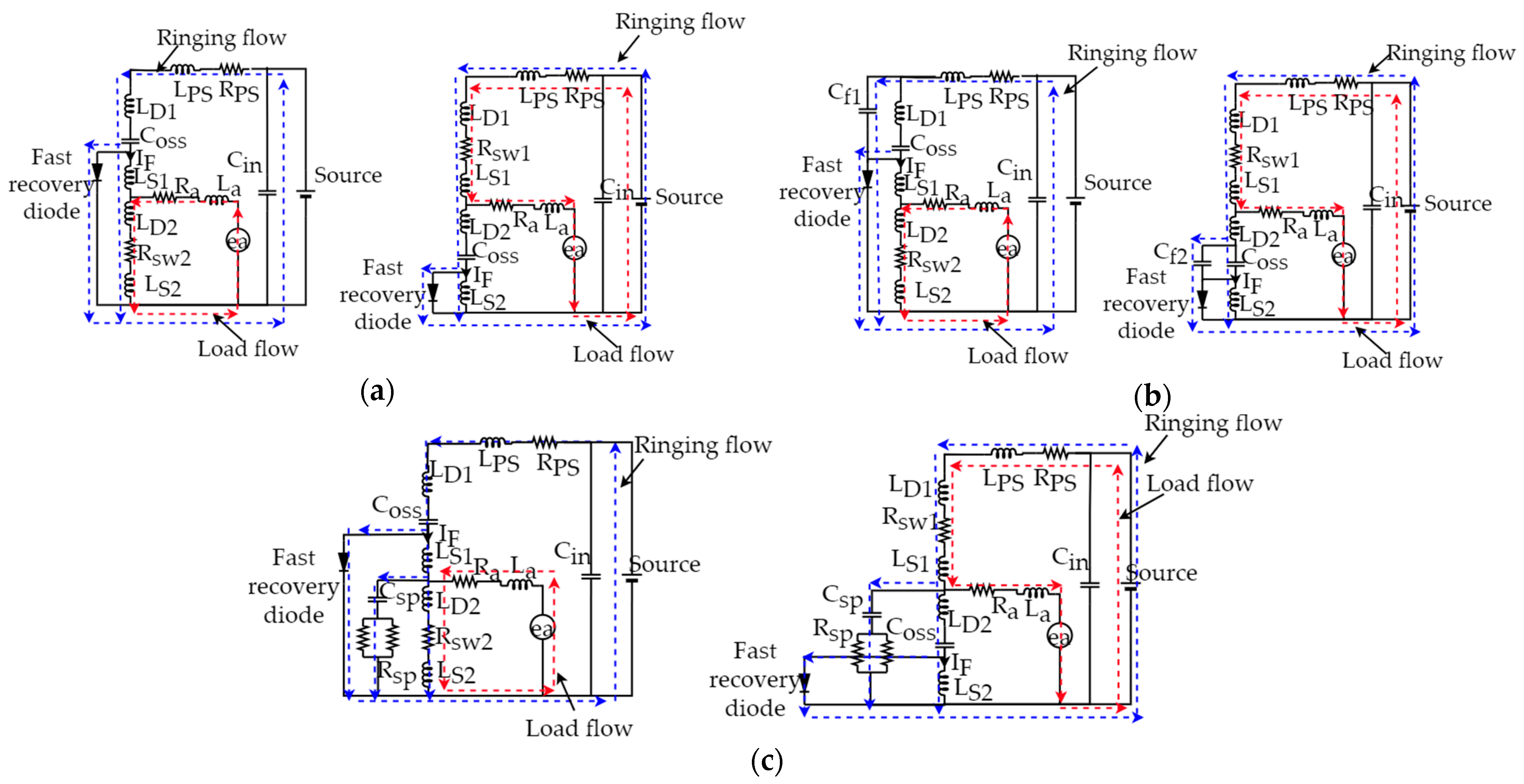

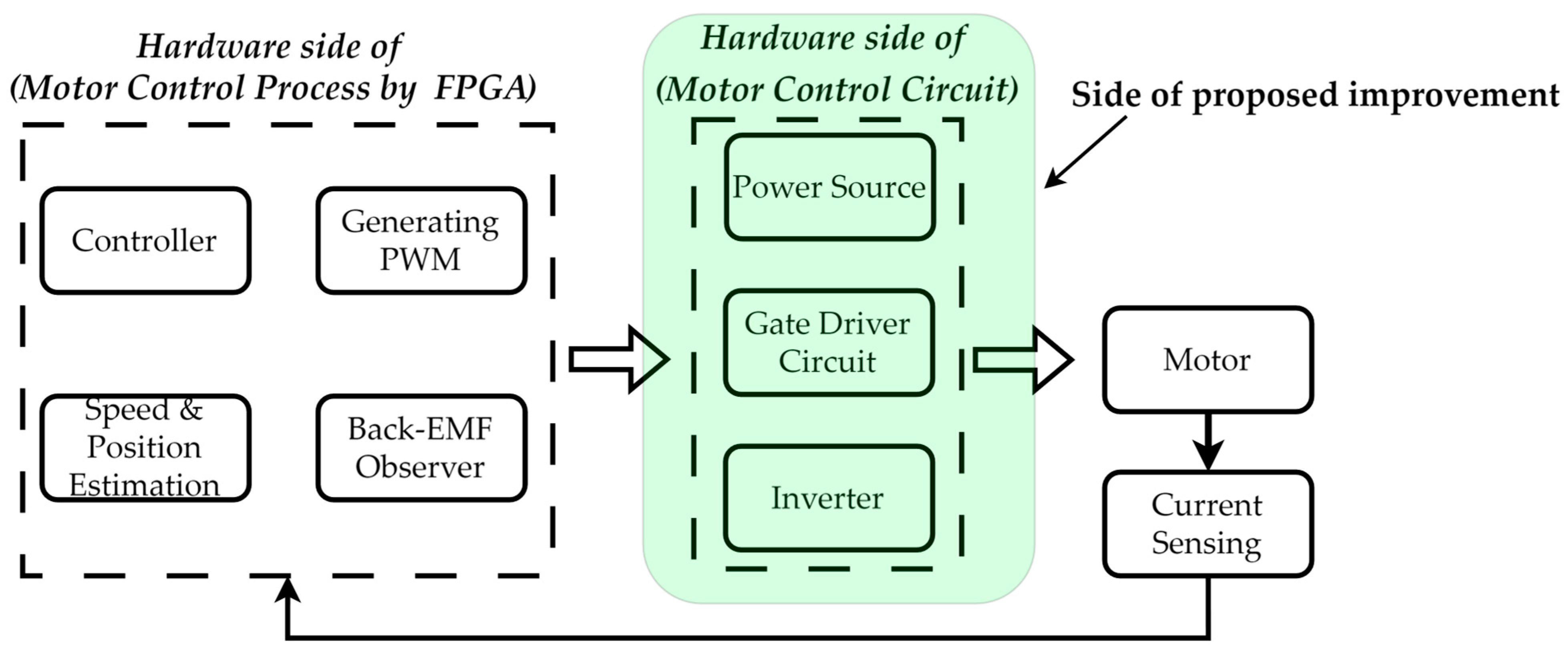
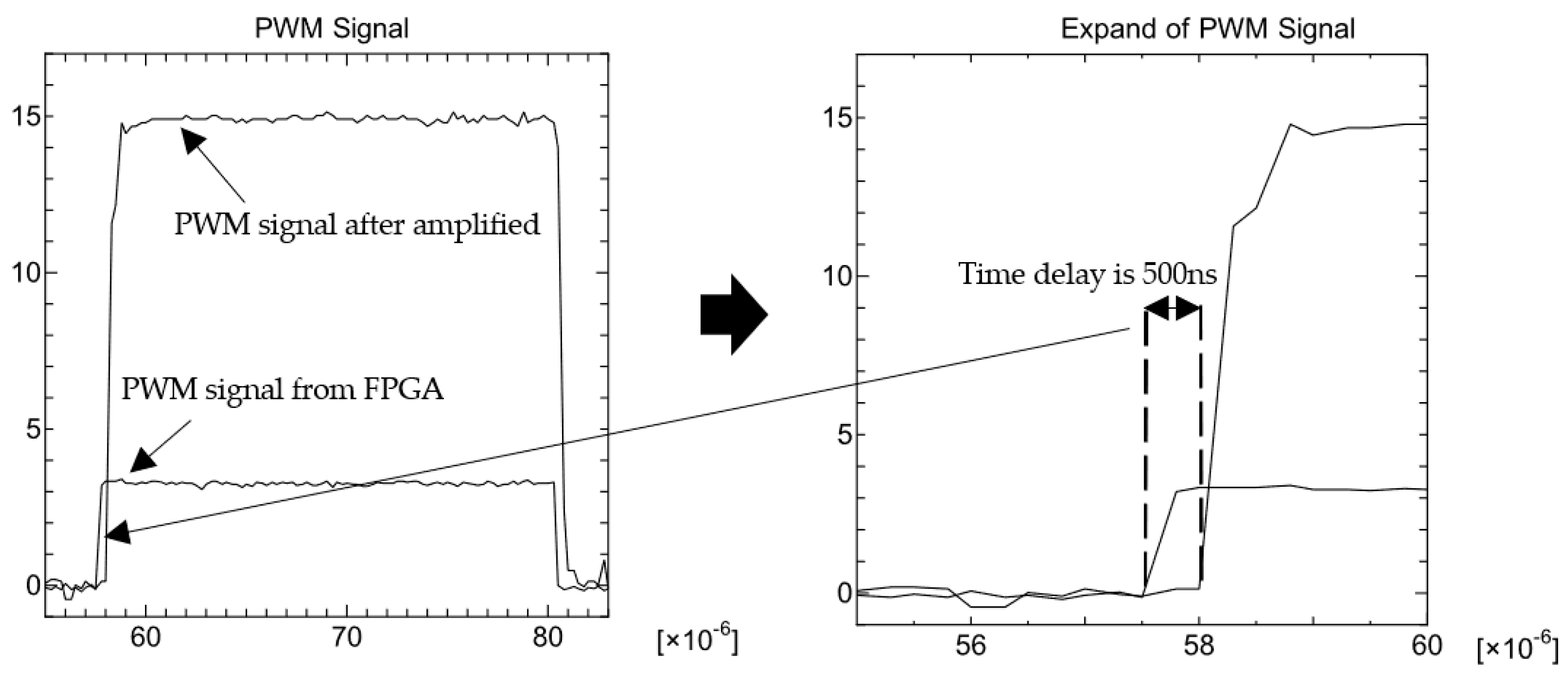

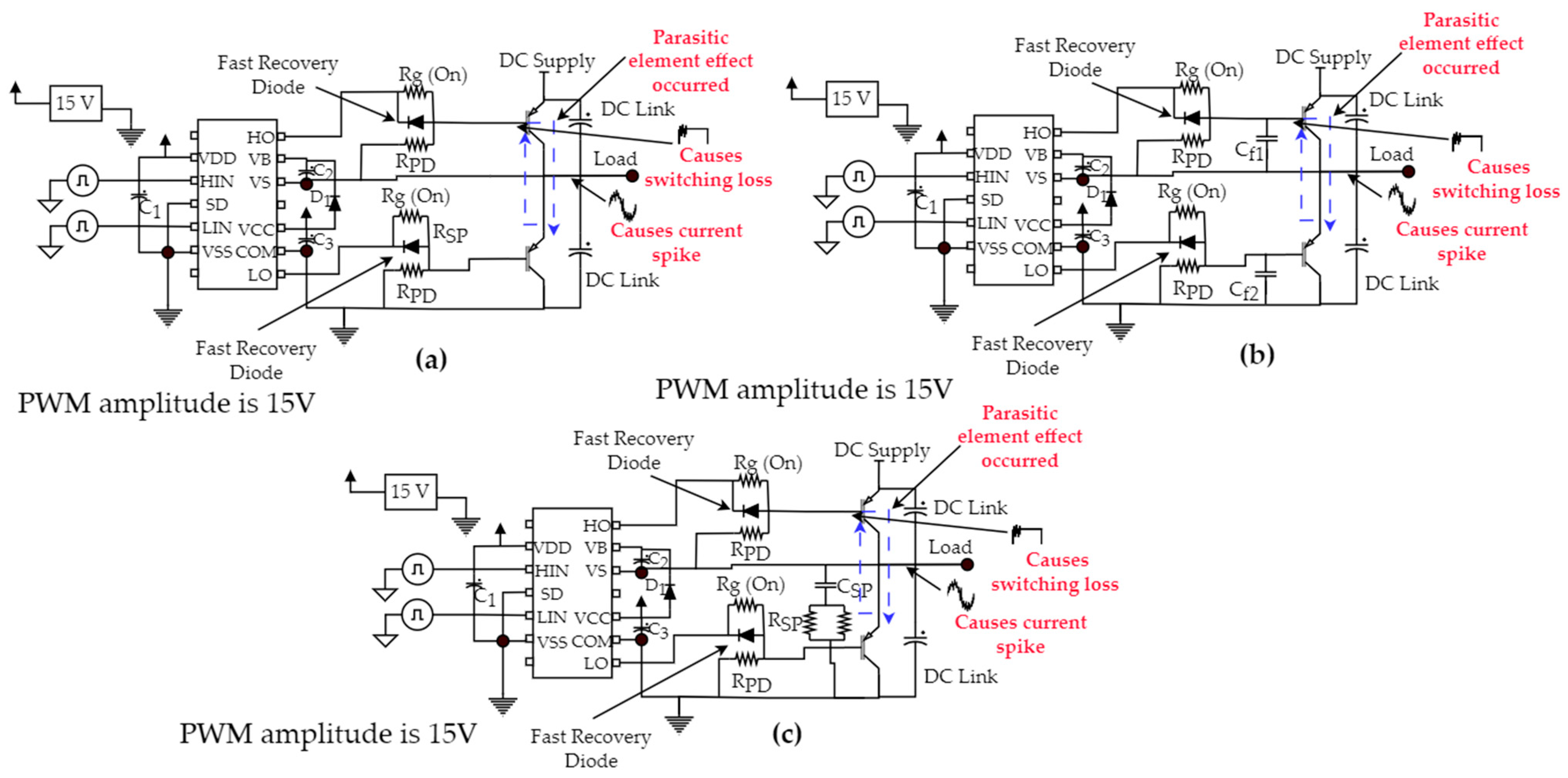
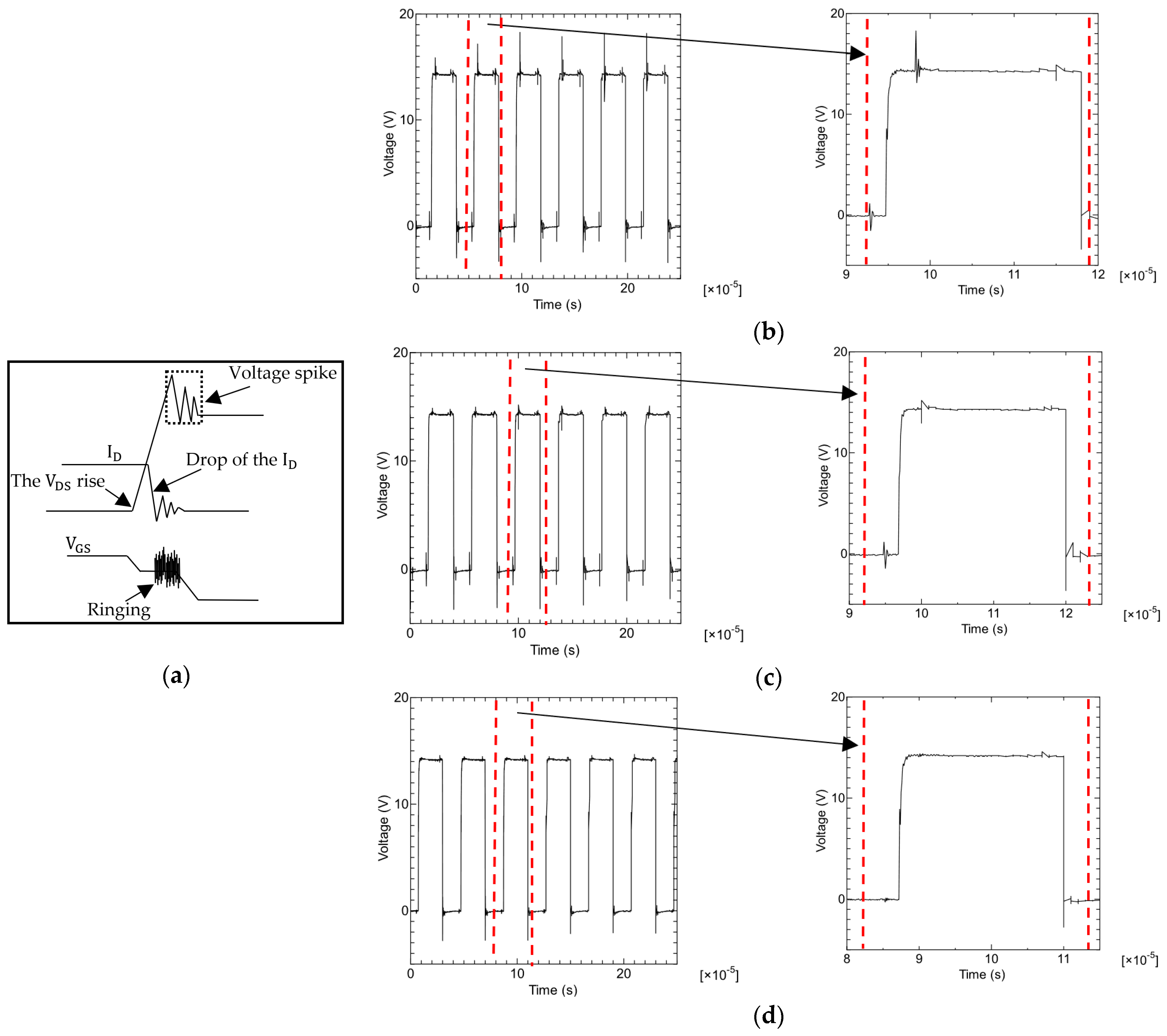
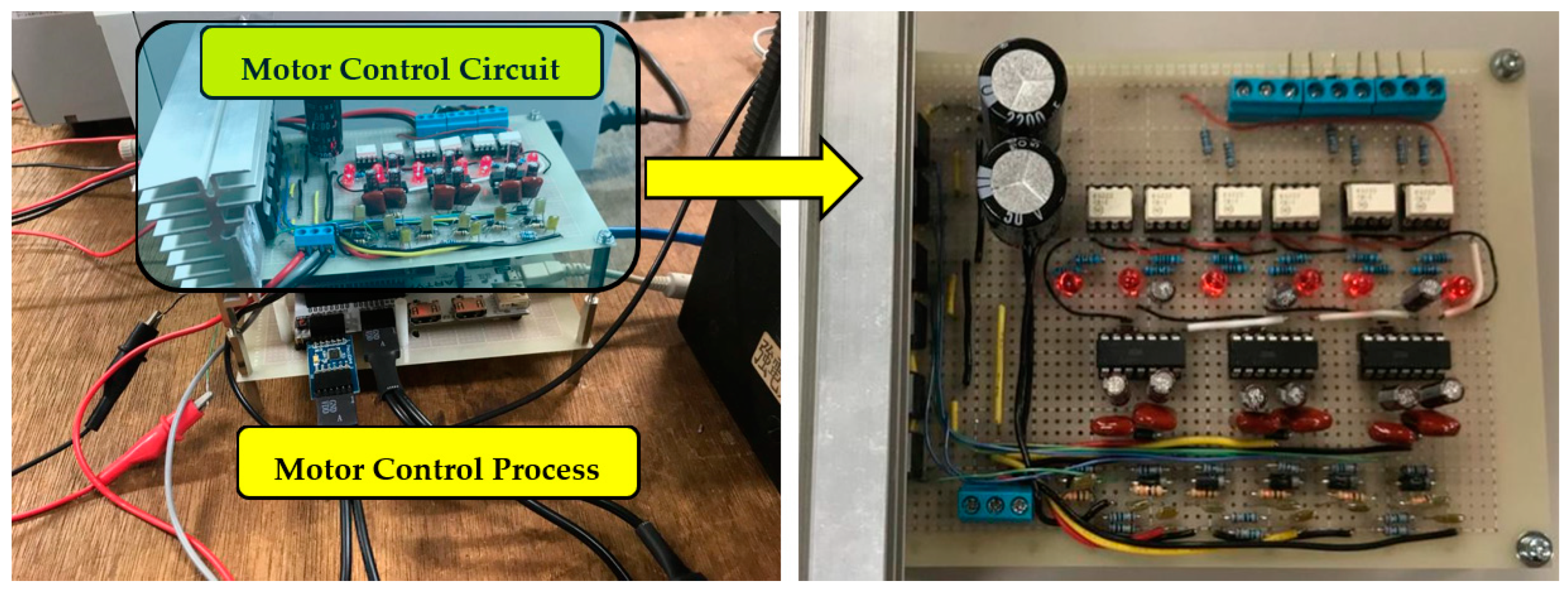

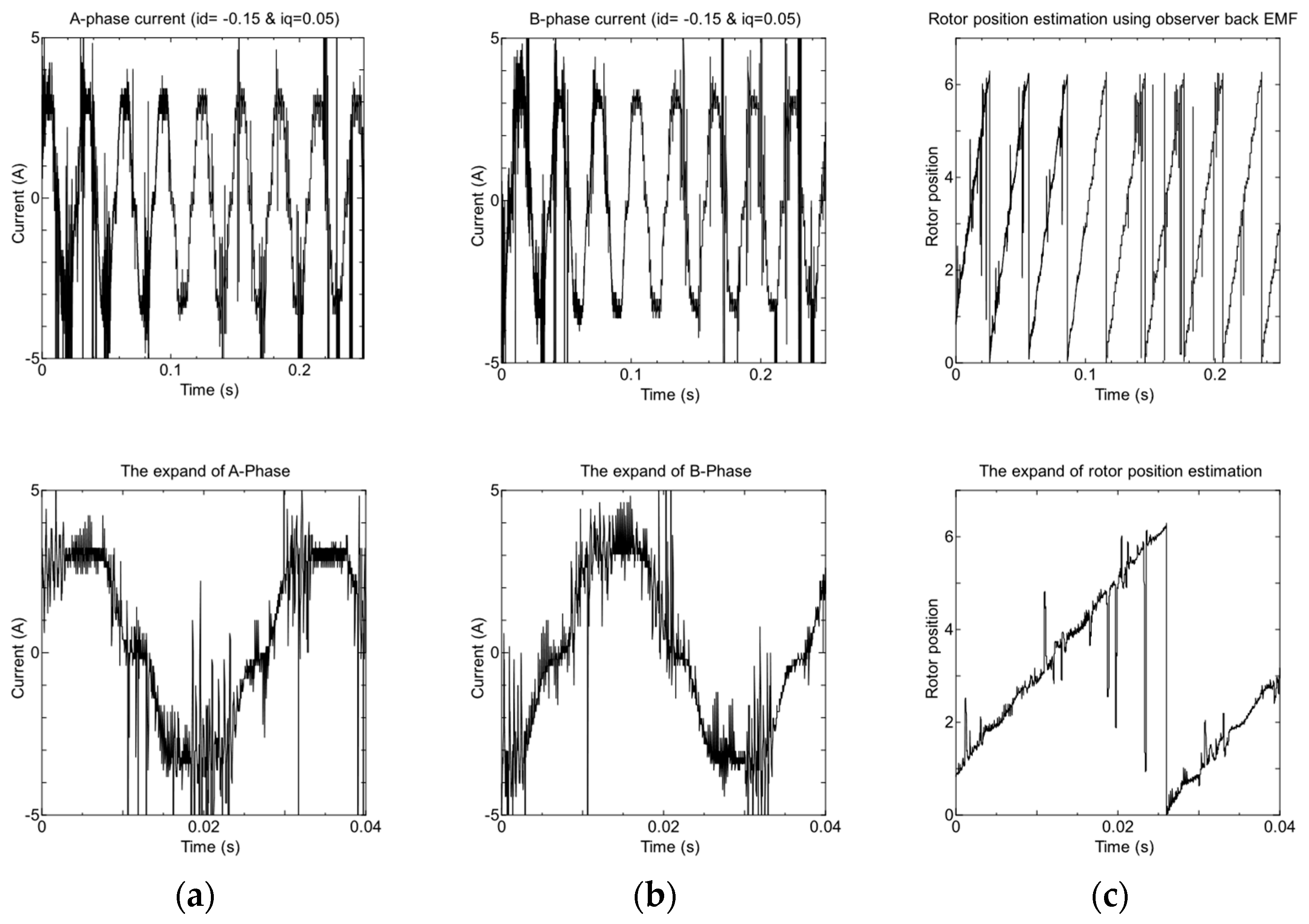


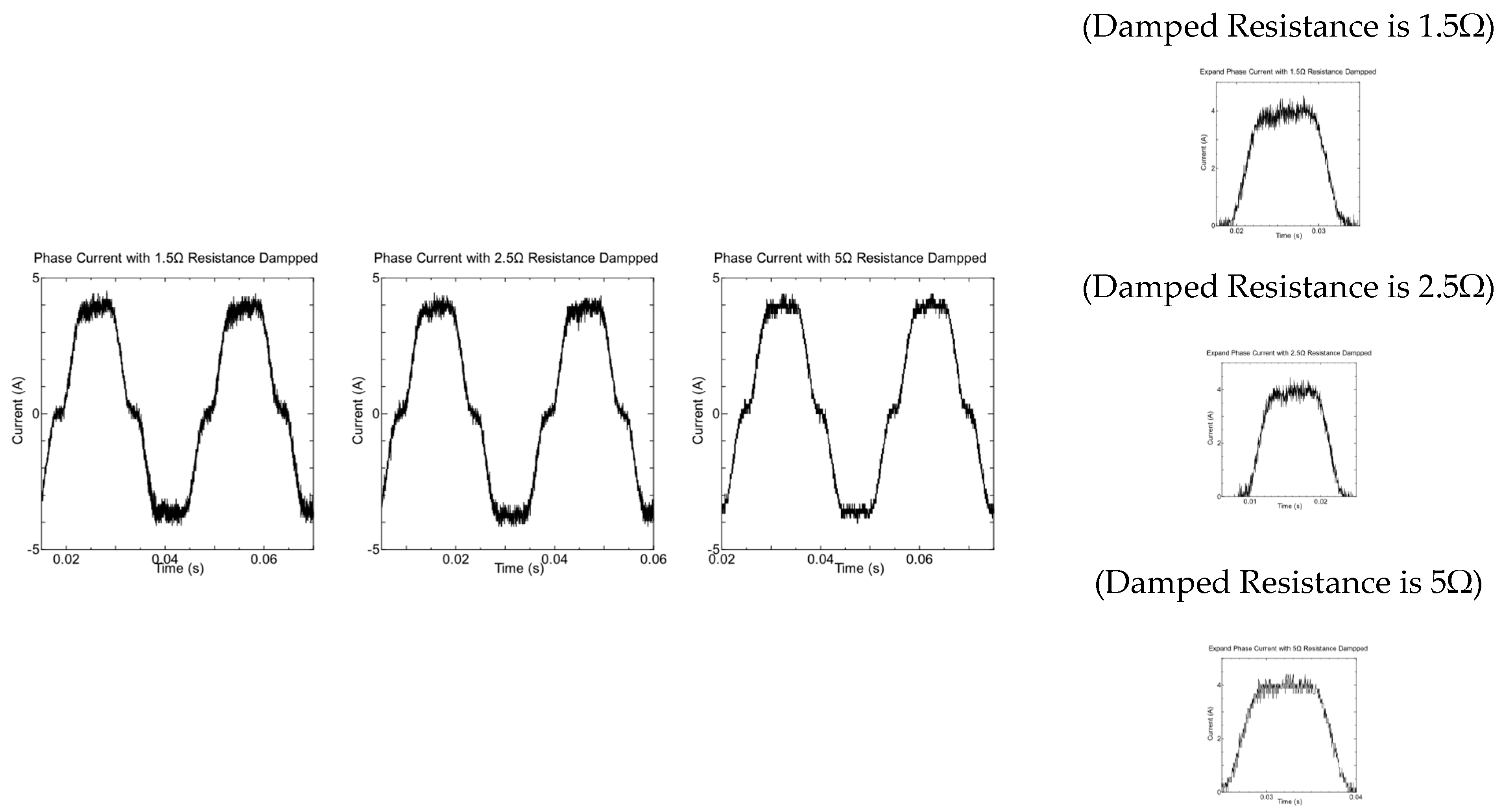
| Components | Specifications |
|---|---|
| DC Power Supply | (PSF-800L), (PW 18-1.3AT) |
| PMSM | DTBL-3518X (4 pole, 185 W, 15A) |
| Current Sensor | PmodISNS20 (ACS722-20A) |
| ADC | ADCS7476 (12 bit with rate conversion 1MSPS) |
| FPGA | ARTY Z7 pynq-20 |
| Memory Hi-CORDER | Hioki 8860-50 |
| PC Interface | Intel(R) Core (TM) i5-7200U |
| Type of Configuration | Max. Current Spike | Max. Oscillation Time | Impact of Motor Current | Impact of Rotor Position Estimation |
|---|---|---|---|---|
| Typical configuration | 33% | 4 ms | Large noise spike occurred | |
| Configuration with filter C | <30% | 2 ms | Large noise spike occurred | |
| Proposed configuration | <10% | <1 ms | Large noise spike not occurred | |
Disclaimer/Publisher’s Note: The statements, opinions and data contained in all publications are solely those of the individual author(s) and contributor(s) and not of MDPI and/or the editor(s). MDPI and/or the editor(s) disclaim responsibility for any injury to people or property resulting from any ideas, methods, instructions or products referred to in the content. |
© 2024 by the authors. Licensee MDPI, Basel, Switzerland. This article is an open access article distributed under the terms and conditions of the Creative Commons Attribution (CC BY) license (https://creativecommons.org/licenses/by/4.0/).
Share and Cite
Ferdiansyah, I.; Hanamoto, T. Design and Implementation of Improved Gate Driver Circuit for Sensorless Permanent Magnet Synchronous Motor Control. World Electr. Veh. J. 2024, 15, 106. https://doi.org/10.3390/wevj15030106
Ferdiansyah I, Hanamoto T. Design and Implementation of Improved Gate Driver Circuit for Sensorless Permanent Magnet Synchronous Motor Control. World Electric Vehicle Journal. 2024; 15(3):106. https://doi.org/10.3390/wevj15030106
Chicago/Turabian StyleFerdiansyah, Indra, and Tsuyoshi Hanamoto. 2024. "Design and Implementation of Improved Gate Driver Circuit for Sensorless Permanent Magnet Synchronous Motor Control" World Electric Vehicle Journal 15, no. 3: 106. https://doi.org/10.3390/wevj15030106






